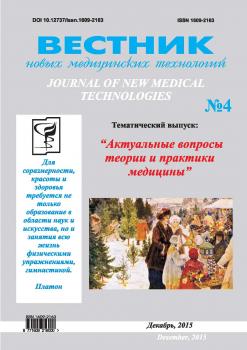. Portable actigraph units allow to long-term of monitoring human cycles and can also be used to quantify the symp-toms of various diseases. The authors studied some applications of actigraphy as analytical methods that are sufficiently sensitive and reliable to determine the severity and consequences of neurological disorders, such as restless legs syndrome, periodic limb movements in sleep, sleep disorders, Parkinson´s disease, depression, behavioural and psychological symptoms in vascular dementia, seasonal affective disorders and acute ischemia of the brain, and the effects of clinical interventions used to treat them. Further research should develop analytical methods to assess other neurological diseases by actigraphic registration.
actigraphy, quantitative assessment of severity, neurological disorders, movement disorders.
1. Pan W., Ohashi K., Yamamoto Y., Kwak S. Pow-er-law temporal autocorrelation of activity reflects severity of parkinsonism. MovDisord. 2007. 22. P. 1308-1313.
2. Van Someren E.J., Pticek M.D., Speelman J.D., Schuurman P.R., Esselink R., Swaab D.F. New actigraph for long-term tremor recording. MovDisord. 2006. V. 21. N8. P. 1136-1143.
3. Pan W., Kwak S., Li F., Wu C., Chen Y., Yamamoto Y., Cai D. Actigraphy monitoring of symptoms in patients with Parkinson´s disease. Physiol&Behav. 2013. V. 119. P. 156-160.
4. Sun Y., Wu C., Wang J., Pan W. Quantitative evaluation of movement disorders by specified analysis according to actigraphy records. Int J Integr Med. 2013. N1. P. 8. DIO:https://doi.org/10.5772/56338
5. Girardin Jean-Louis, Sleep estimation from wrist activity in patients with major depression, Physiology & Behavior 70 (2000) 49-53.
6. Steven W. Lockley, Comparison between subjec-tive and actigraphic measurement of sleep and sleep rhythms. J Sleep Res. 1999. N. 8. P. 175-183.
7. Associations Between Obstructive Sleep Apnea, Metabolic Syndrome, and Sleep Duration / Chin K., [et al.]. As Measured With an Actigraph, in an Urban Male Working Population in Japan, Sleep. 2010. V. 33. N1. P. 89-95.
8. Pan W., Soma R., Kwak S., Yamamoto Y. Im-provement of motor functions by noisy vestibular stimulation in central neurodegenerative disorders. J Neurol. 2008. 255. 1657-1661.
9. Quantitative evaluation of severity of behavioral and psychological symptoms of dementia in patients with vascular dementia / Pan W., Yoshida S., Liu Q., Wu C. [et al.]. Transl Neurodeger. 2013. 2. P. 9. DOI:https://doi.org/10.1186/2047-9158-2-9.
10. Plante DT. Leg actigraphy to quantify periodic limb movements of sleep: a systematic review and meta-analysis. Sleep Med Rev. 2014. 18(5). P. 425-434.
11. Insomnia Symptoms and Actigraph-Estimated Sleep Characteristics in a Nationally Representative Sample of Older Adults / Chen J.H., Waite L., Kurina L.M., Thisted R.A. [et al.]. J Gerontol A BiolSci Med Sci. 2014 Sep 8.pii: glu144. PubMed PMID: 25199910.
12. Actigraph evaluation of acupuncture for treat-ing restless legs syndrome / Pan W., Wang M., Li M., Wang Q. [et al.]. Evidence-based Complementary and Alternative Medicine, 2014.
13. Katayama S. Actigraph analysis of diurnal mo-tor fluctuations during dopamine agonist therapy. Eur Neurol. 2001. 46 Suppl 1. P. 11-17.
14. A compound belonging to traditional Chinese medicine improves nocturnal activity in Parkinson’s disease / Pan W., Kwak S., Liu Y., Fang Z. [et al.]. Sleep Med. 2011. 12. P. 307-308.
15. Therapeutic effect of Yang-Xue-Qing-Nao gra-nules on sleep dysfunction in Parkinson’s disease. Pan W., Kwak S., Li G., Chen Y. [et al.]/ Chin Med. 2013. 8:14 doihttps://doi.org/10.1186/1749-8546-8-14
16. Qi C., Song X., Wang J., Qin B., Pan W., Su X. Bufei Huoxue capsules improve sleep disorders in geriatric chronic obstructive pulmonary disease. Shang HaiZhong Yi Yao Da XueXueBao. 2013. 47(8). P. 35-38.
17. Ohashi K., NunesAmaral L.A., Natelson B.H., Yamamoto Y. Asymmetrical singularities in real-world signals. Phys Rev E Stat Nonlin Soft Matter Phys. 2003. 68. 065204
18. Pan W., Kwak S., Liu Y., Sun Y., Fang Z., Qin B., Yamamoto Y. Traditional Chinese medicine improves activities of daily living in Parkinson’s disease. Parkinsons Dis. 2011.doihttps://doi.org/10.4061/2011/789506
19. International study on the psychometric attributes of the non-motor symptoms scale in Parkinson disease / Martinez-Martin P., Rodriguez-Blazquez C., Abe K., Bhattacharyya K.B. [et al.]// Neurology. 2009. 73(19). P. 1584-1591.
20. Comella C.L., Morrissey M., Janko K. Nocturnal activity with nighttime pergolide in Parkinson disease: a controlled study using actigraphy. Neurology. 2005. 64(8). P. 1450-1451.
21. Bakken L.N., Kim H.S., Finset A., Lerdal A. Stroke patients´ functions in personal activities of daily living in relation to sleep and socio-demographic and clinical variables in the acute phase after first-time stroke and at six months of follow-up. J ClinNurs. 2012. 21(13-14). P. 1886-1895.
22. Ohashi K., Polcari A., Teicher M.H. Scale-Invariant Locomotor Activity Patterns in Children with SAD. Int J Integr Med. 2013. 1. P. 12. DOI:https://doi.org/10.5772/56408.
23. Ohashi K, Yamamoto Y, Teicher MH. Locomo-tor micro-activities associated with therapeutic res-ponses in patients with seasonal affective disorders. Integrative Medicine International. 2014. 1(2). In Press
24. Hu K., Van Someren E.J., Shea S.A., Scheer F.A. Reduction of scale invariance of activity fluctuations with aging and Alzheimer´s disease: Involvement of the circadian pacemaker. Proc NatlAcadSci U S A. 2009; 106(8):2490-4.
25. Pan W and Zhou H. InclusionofIntegrativeMedicineinClinicalPractice. Integrative Medicine Interna-tional. 2014. 1(1). R. 1-4.





